
THE COLLECTION - Bikes for Sale - About Bar - Current Projects - Links - Archives - Contact - Main

Origainally published in International Motorcycle Magazine, Volume 17, Issue 1 January 2007. | |
Vincent - Vintage RestorationWords and Photos By Phil Mahood
| |
Resurrection of a Prodigal SonVincent motorcycles are like old friends, or prodigal sons. They may leave us for a while, on this or that adventure. But if we wait long enough, they come back into our lives. For me, the 1953 Vincent Rapide featured in this year's SUPERSHOW followed that story line.The big 998 cc V-twin started its life in England. Some time in the 1960s, like so many other Vincents, it was abandoned and left to deteriorate in a damp garden shed. Somehow, perhaps after the shed collapsed, it found its way to a London dealer where it was cannibalized to keep other machines running. It was finally rescued in 1974 when I purchased the carcass, along with the dealer's entire stock of used Vincent parts. All five tons of the picked-over bones came to Canada.
| |
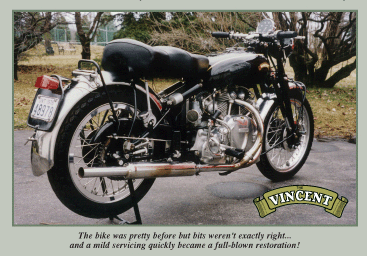
|
The bike's existence on these shores came to the attention of would-be Vincent owner Byrne Bramwell, an Ottawa engineer. The bike was in a truly frightful state. Corrosion and rust had destroyed all the sheet metal and deeply pitted most of the heavier parts. All the nuts and bolts were junk. Tank? Seat? Wheels? Brakes? Electrics? Forget it. The elements and scavengers had consumed all those things long ago. In the plus column, the major engine castings had no damage whatsoever. There wasn't a stripped thread or a broken stud anywhere. Importantly, the original frame and engine numbers matched, a big bonus from a collector's point of view.
|
|
Having already restored a couple of Vincent twins, I did my very best to discourage Byrne. Dire warnings were issued about the challenges ahead, not to mention the expense of bringing such a basket case back to life. All this was respectfully, and thankfully ignored. Byrne clearly had what it took to see the job through. My conscience was clear, and I let him take the bike. I also gave Byrne first dibs of anything he wanted out of my now gigantic stock of spares. With Italian alloy rims from here, flywheels from there, and even some Japanese electrics, the project moved from long shot status to hmm, maybe we have something here. All the hardware was replaced with stainless steel parts from the Vincent Owners Club Spares Company. In late 1975, the beast came back to life, albeit with many non-standard parts.
|
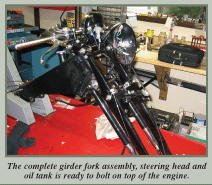
|
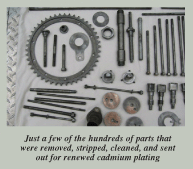 That project was just a warm up for Byrne Bramwell. Other Vincents followed. Soon the Rapide was sold to a dealer in Eastern Ontario. Once again the bike was stored, and finally left to languish in a basement for years. Rescued a second time by Bar Hodgson, the bike was spruced up, ridden occasionally, and was on regular display at many SUPERSHOWs. Although it was a nice running example of a Vincent, it was what we now call an "older restoration". This is a polite way of saying that the standards these days are, ahem, much higher. The bike had developed a few problems too. The most glaring issue was a leak between the rear cylinder head and barrel. It was time for a second rebuild. Bar called me with a question. How would I like to restore the bike I'd sold exactly 30 years ago?
That project was just a warm up for Byrne Bramwell. Other Vincents followed. Soon the Rapide was sold to a dealer in Eastern Ontario. Once again the bike was stored, and finally left to languish in a basement for years. Rescued a second time by Bar Hodgson, the bike was spruced up, ridden occasionally, and was on regular display at many SUPERSHOWs. Although it was a nice running example of a Vincent, it was what we now call an "older restoration". This is a polite way of saying that the standards these days are, ahem, much higher. The bike had developed a few problems too. The most glaring issue was a leak between the rear cylinder head and barrel. It was time for a second rebuild. Bar called me with a question. How would I like to restore the bike I'd sold exactly 30 years ago?
| |
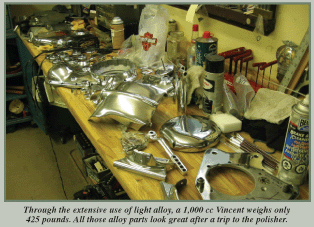 It may be hard to comprehend for owners of modern bikes, but the Vincent parts situation has never been better. As a demonstration of its capabilities, the Vincent Owners Club Spares Company recently assembled a complete Vincent to original specifications from new parts available off their shelves. Try that with your typical three-year old Japanese sport bike! Even better, the quality of these new Vincent parts far exceeds what the factory produced on worn out, post-WWII machinery. By the way, in spite of constant rumours, there is no plan to reproduce complete Vincent motorcycles. Take it from me.
It may be hard to comprehend for owners of modern bikes, but the Vincent parts situation has never been better. As a demonstration of its capabilities, the Vincent Owners Club Spares Company recently assembled a complete Vincent to original specifications from new parts available off their shelves. Try that with your typical three-year old Japanese sport bike! Even better, the quality of these new Vincent parts far exceeds what the factory produced on worn out, post-WWII machinery. By the way, in spite of constant rumours, there is no plan to reproduce complete Vincent motorcycles. Take it from me.
| |
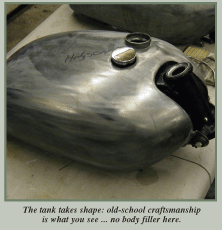 Originally, Bar Hodgson simply wanted the cylinder head leak fixed and for the bike to start and run better. Bar is a certified motorcycle mechanic himself, and maintains all the museum bikes in top working order. But a Vincent is another matter. A quick disassembly revealed all. But, before proceeding, one more thing was needed - a philosophy. "What? Can't we just fix the thing and put it back on the road?" asked Bar. "Oh, I suppose. But let me give you some options. We could have an oily-rag type working bike, a trailer queen, a perfect original example, a hot rod, a touring bike, or combinations of any of these." I explained. "I see. I guess this is not so simple."
Originally, Bar Hodgson simply wanted the cylinder head leak fixed and for the bike to start and run better. Bar is a certified motorcycle mechanic himself, and maintains all the museum bikes in top working order. But a Vincent is another matter. A quick disassembly revealed all. But, before proceeding, one more thing was needed - a philosophy. "What? Can't we just fix the thing and put it back on the road?" asked Bar. "Oh, I suppose. But let me give you some options. We could have an oily-rag type working bike, a trailer queen, a perfect original example, a hot rod, a touring bike, or combinations of any of these." I explained. "I see. I guess this is not so simple."
| |
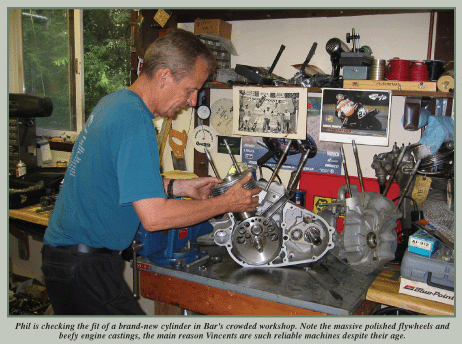
|
After much discussion, and only a little arm-twisting on my part, we settled on a sort of "Gentleman's Express" concept. It was to look original and be tuned for quiet, smooth operation. It would be a signature show bike capable of winning awards against the toughest competition. But it would start on the first kick, and run any time Bar wanted. With a museum full of bikes, we can't have a fussy thing that needs a day of tinkering every time the boss wants to air it out. It would pack all the monster low-end and mid-range torque that the Vincent is legendary for. It would have the effortless high-speed cruising and light, stable handling too.
|
|
In other words, it would be a fast, devastating puncher covered by a velvet glove and disguised with impeccable manners.
| |
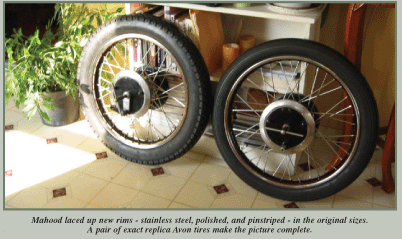 The leaking cylinder head turned out to be a common problem on aging
Vincents. After more than 50 years, metal fatigue had allowed the alloy cylinder casting to distort. We could have re-machined the original, fitted oversize liners, etc. But brand-new assemblies of superior quality are available. That turned out to be the soundest and most cost-effective fix. As we turned over those dazzling, beautiful, perfect new bits, a curious thing began to happen.
The leaking cylinder head turned out to be a common problem on aging
Vincents. After more than 50 years, metal fatigue had allowed the alloy cylinder casting to distort. We could have re-machined the original, fitted oversize liners, etc. But brand-new assemblies of superior quality are available. That turned out to be the soundest and most cost-effective fix. As we turned over those dazzling, beautiful, perfect new bits, a curious thing began to happen.
| |
|
It is known among home renovators as the "Now That Syndrome". NTS goes something like this. Now that we have the nice tiles on the kitchen floor, we owe it to ourselves to upgrade the cabinets. Now that we have those, we better put in the granite counter tops. Now that we have all this, better have the top-of-the-line plumbing fixtures too. And so it went with the Vincent. A quick spruce up became a ground-up rebuild of everything. The syndrome started in the engine and spread. We bought new F1-quality cams, new followers, and die-cast close-tolerance pistons. The alloy aluminum engine covers, a big feature of the Rapide, were buffed to a high luster, with care taken not to damage the original cast-in maker's logos and trade marks. With such a jewel of an engine, the chassis was now looking decidedly shabby. Worse, from 20 feet, the overall bike just didn't have "the look". The modern wheels and fat tires were all wrong. The radius of the front fender didn't match the tire. The rear number plate and tail light were rough aftermarket reproductions. The signature exhaust system was deeply discoloured and made up of poorly-fitted and finished pipes. Finally, the tank just wasn't right. Oddly, it looked swollen. Had there been an explosion? Fire damage? A failed attempt to pop out a dent with compressed air? We'll never know.
| |
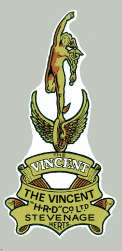 A search for a new item, or a better second-hand item, turned up nothing acceptable. The solution turned up in the form of a local sheet metal genius. Off went the pregnant-looking tank to Ross Thompson Metal Finishing for massaging. It came back in only one week looking slim, trim, and perfectly aligned. Next, I laced up a gorgeous set of new standard rims of the original sizes. These are stainless steel, polished and pinstriped. I spooned on a pair of exact replica original Avon tires. Out went the fenders and braces that were slightly off.
A search for a new item, or a better second-hand item, turned up nothing acceptable. The solution turned up in the form of a local sheet metal genius. Off went the pregnant-looking tank to Ross Thompson Metal Finishing for massaging. It came back in only one week looking slim, trim, and perfectly aligned. Next, I laced up a gorgeous set of new standard rims of the original sizes. These are stainless steel, polished and pinstriped. I spooned on a pair of exact replica original Avon tires. Out went the fenders and braces that were slightly off. Now we had the right Vincent silhouette - slim, lithe, and rapier sharp. From a few steps back, it really was a stunner. Alas, shabby wiring, faded paint, and tarnished metal were spoiling the picture. All parts were stripped and painted to match. Hours were spent wire brushing and polishing every nut and bolt. All that hardware was sent out for cadmium plating, as per original. There are only a few chrome parts on a Vincent. But all these were redone. The icing on the cake was a new exhaust system made from the original factory jig.
| |
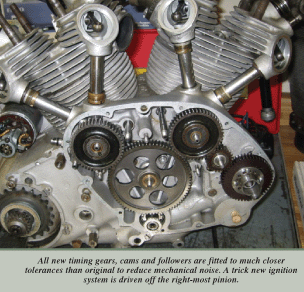 The above gives one a general idea of the eight-month project. In fact, there were dozens of small details and decisions along the way. Often I felt guilty when I'd go to Bar to suggest yet another upgrade. "See this widget, Bar? I could make it look reasonable and put it back on. It'll work, no problem. But it's not really quite right. This curve is not really correct and there should be a spring tab there. To a real Vincent guy, it'll stick out like a sore thumb. Sleep on it." Invariably, Bar would step up and go for it.
The above gives one a general idea of the eight-month project. In fact, there were dozens of small details and decisions along the way. Often I felt guilty when I'd go to Bar to suggest yet another upgrade. "See this widget, Bar? I could make it look reasonable and put it back on. It'll work, no problem. But it's not really quite right. This curve is not really correct and there should be a spring tab there. To a real Vincent guy, it'll stick out like a sore thumb. Sleep on it." Invariably, Bar would step up and go for it.Yes, the bike is a runner. But, it is also a museum piece. As such, it will stand out as a reference example to the greatest degree possible. Great classic motorcycles like the Vincent will last forever. We like to think that we own them while they are in our garages. Yet, I suspect the opposite is true. These machines speak to us and tell us what they need. We obey. We do their bidding. We are just their temporary caretakers on their path through our lives.
| |
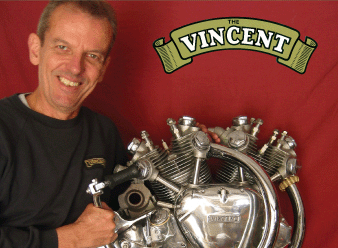
|
This Vincent Rapide has spoken to Bar Hodgson from some corner of his shop. The result is at the SUPERSHOW for everyone to enjoy, and final photos and details will be in the next issue of International Motorcycle at the Spring Show in April. At first this may seem to be a curious statement from a man spinning wrenches on one of the all time great classic bikes, the Canadian Motorcycle Heritage Museum's 1953 Vincent Rapide.
|
|
One reason is that the Vincent is so utterly unconventional in everyengineering respect; it borrows virtually nothing from any other design. It is as if the makers deliberately stepped away from every conventional thought. Perhaps this explains my fanatical devotion; I've made these machines the subject of a lifetime of study. Many of the more than 2,000 members of the Vincent Owners Club immerse themselves in these machines to the exclusion of all other, what they consider to be inferior, brands.
|
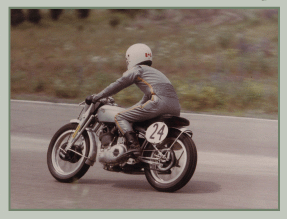
|
|
While it is true that I have walked that path on the way to becoming, I think, a widely-recognized authority on Vincents, I came by my Vincent credentials the old-fashioned way. My very first motorcycle was a 1951 Vincent Rapide bought in 1966 with my first pay cheques after graduating from high school. That act got me turfed out of the family home - motorcycles were not an acceptable form of transportation in those days.Undeterred, I went on to build another dozen machines over the next four decades. I'm pretty practical at heart, and always rode the bikes I built. In 1980, I rode my Black Shadow from Toronto to Los Angeles to attend a Vincent rally, where the machine won a concours trophy and an award as the best-running bike against a field of more than 80 entries. Maintenance during the trip? Two chain adjustments. Still in the show area, I've been a judge at several international rallies in Europe and North America. Looking for new fields to conquer, I built up a competitive Vincent for vintage road racing and campaigned it throughout North America, including Daytona. This led to a long racing career on Ducati bevel drive twins - one of the few acceptable diversions among true-blue Vincent owners! Today, I'm busy building, tuning, and refining Vincents for a new generation of enthusiasts, with the idea of keeping these magnificent machines on the road and in everyday use. Always trying to learn and grow, I've taken up dirt riding and use a BMW F650 Dakar dual-sport bike for daily transportation, and am the organizer of the Ontario Section of the Vincent Owners Club. http://www.voc.uk.com/.
| |
The Collection - Bikes for Sale - About Bar - Current Projects - Links - Archives - Contact - Main